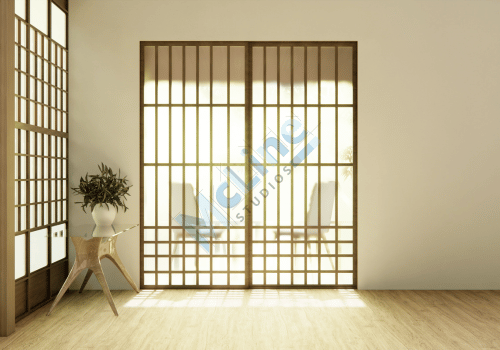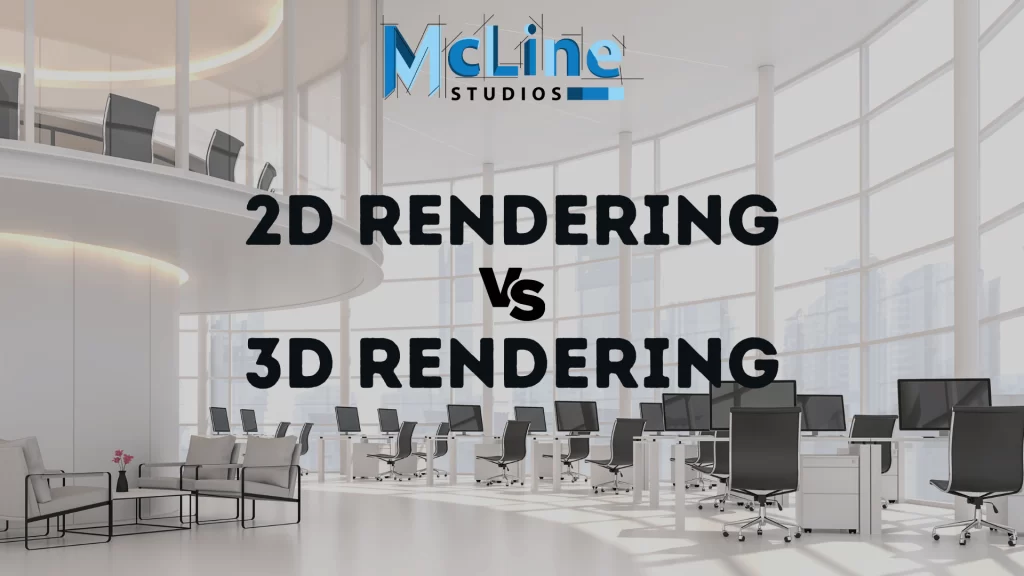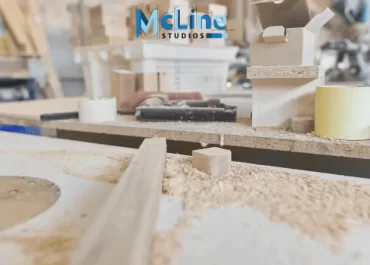There are two main approaches to visualize the image, 2D rendering and 3D rendering. 2D Rendering involves creating flat, two-dimensional images, like drawings or photographs. These images have no depth or dimension, and they only show the front view of an object or scene.
On the other hand, 3D rendering creates three-dimensional images that have depth and can be viewed from different angles. These images are created using computer software that simulates the way light interacts with objects in a virtual 3D environment.
3D rendering allows for more realistic and immersive visuals, making it widely used in fields like animation, video games, architecture, and product design. While 2D rendering is simpler and faster, 3D rendering offers more versatility and realism, but it can be more complex and time-consuming.
Let’s understand both aspects of image visualization in detail and understand which would be the best for your next project.
What is 2D Rendering?

2D rendering refers to the process of generating images from 2-dimensional geometric data for display on a screen or in print. It is a fundamental aspect of computer graphics used in various applications ranging from architecture, video games, and animation to graphic design and scientific visualization.
In 2D rendering, graphical elements such as lines, shapes, and text are manipulated and transformed according to algorithms to create a final image. This involves tasks like rasterization, where geometric primitives are converted into pixels, and shading, where the color and intensity of pixels are determined based on lighting models and material properties.
Rendering engines typically utilize techniques such as anti-aliasing to smooth out jagged edges and improve visual quality, as well as transparency and blending for compositing multiple layers of graphics.
Role of 2D Rendering in Architecture
2D Rendering serves as a fundamental tool in architecture throughout the process of drafting and design. Let’s take a closer look at the significance of 2D Rendering in Architecture.
- Conceptualization and Ideation: At the initial stages of a project, architects often rely on hand-drawn sketches or 2D architectural renderings to explore and develop their design ideas. These renderings allow them to quickly visualize concepts, experiment with various layouts, and communicate their vision to clients and team members.
- Communication and Collaboration: 2D renderings serve as effective communication tools between architects, clients, engineers, and other stakeholders involved in the project. They convey design intent, spatial relationships, and aesthetic qualities clearly and understandably, fostering collaboration and consensus-building among the project team.
- Analysis and Evaluation: Before committing to detailed 3D models and construction drawings, architects use 2D renderings to analyze and evaluate design alternatives. By creating floor plans, elevations, and sections, architects can assess factors such as scale, proportion, circulation, and spatial organization, ensuring that the design meets functional requirements and adheres to building codes and regulations.
- Documentation and Permitting: 2D renderings are essential for producing the technical drawings and documentation required for obtaining building permits and approvals from regulatory authorities. Detailed plans, sections, and elevations accurately depict the architectural components of the project, including dimensions, materials, finishes, and structural details, facilitating the review and approval process.
What is 3D Rendering?

3D rendering is the process of generating two-dimensional images from three-dimensional models using computer software. It simulates how light interacts with objects in a virtual environment to create realistic representations. This technology is widely utilized across various industries, including architecture, interior design, gaming, animation, and product design.
In 3D rendering, the software calculates the position, color, and intensity of light sources, as well as the surface properties of objects, such as texture, reflection, and refraction. By employing techniques like ray tracing or rasterization, the software determines how light rays interact with virtual objects to produce accurate shadows, highlights, and reflections, resulting in lifelike imagery.
Artists and designers can manipulate virtual cameras within the software to control perspective, framing, and composition, allowing for the creation of compelling visual narratives. Additionally, advanced rendering techniques like global illumination and ambient occlusion further enhance realism by simulating indirect lighting and shadowing effects.
Role of 3D Rendering in Architecture
3D rendering become an inevitable part of the architectural world. It revolutionized the way architects, designers, and contractors work.
- Visualization and Conceptualization: One of the primary roles of 3D rendering in architecture is its ability to bring architectural concepts to life. Architects can create detailed, photorealistic renderings of their designs, allowing clients, stakeholders, and project teams to visualize the final product long before construction begins. This enhances communication and understanding, enabling better decision-making early in the design process.
- Design Development: 3D rendering facilitates iterative design processes by enabling architects to quickly explore different design options and variations. With the aid of rendering software, architects can experiment with materials, lighting, textures, and spatial arrangements, assessing the aesthetic and functional aspects of their designs in real time. This iterative approach fosters creativity and innovation, leading to more refined and optimized architectural solutions.
- Marketing and Promotion: In addition to aiding client communication, 3D renderings are instrumental in marketing architectural projects. Compelling renderings can be used in brochures, websites, presentations, and advertisements to showcase the unique features and selling points of development. By creating visually stunning representations of their designs, architects can attract potential investors, buyers, and tenants, ultimately driving the success of the project.
- Constructability Analysis: Beyond aesthetics, 3D rendering also assists in assessing the constructability of architectural designs. By generating detailed 3D models, architects can identify potential construction challenges, clash detection, and spatial conflicts early in the design phase. This proactive approach helps minimize errors, reduce costly rework during construction, and improve overall project efficiency.
2D Rendering Vs. 3D Rendering
| Aspects | 2D Rendering | 3D Rendering |
| Dimensionality | Two-dimensional, flat images | Three-dimensional, spatially immersive images |
| Representation | Represents objects and scenes in two dimensions | Represents objects and scenes in three dimensions |
| Depth perception | Limited depth perception | Realistic depth perception |
| Flexibility | Limited flexibility in viewing angles and perspectives | High flexibility in viewing angles and perspectives |
| Complexity | Generally less complex | Can be highly complex with detailed modeling, textures, and lighting |
| Applications | Illustrations, graphic design, animation | Animation, visual effects, architectural visualization, gaming |
| Softwares | Adobe Photoshop, Illustrator, etc. | 3Ds Max, Blender, Cinema 4D, Autodesk Maya, etc. |
What to Choose for Your Next Project?
When deciding between 2D and 3D rendering for your project, consider:
- Project Complexity: 2D rendering suits simpler projects, while 3D rendering is ideal for complex spatial representations.
- Cost and Time: 2D rendering is cost-effective and quicker, whereas 3D rendering offers higher realism but requires more resources and time.
- Artistic Flexibility: 2D allows for diverse artistic styles, while 3D provides depth and realism, suitable for detailed visualizations.
- Audience and Platform: 2D is versatile across platforms, while 3D excels in product visualization and interactive experiences.
- Long-Term Goals: Investing in 3D can future-proof projects and cater to evolving technologies and audience expectations.
Consider your project scope, budget, timeline, target audience, and long-term objectives to make the right choice. Whether aiming for simplicity and affordability or realism and interactivity, selecting the appropriate rendering technique ensures effective project execution and audience engagement.
The End Note
In conclusion, the disparities between 2D and 3D rendering are significant and impactful across various industries. While 2D rendering remains a practical choice for certain applications due to its simplicity and ease of use, 3D rendering offers unparalleled depth, realism, and versatility, making it indispensable for modern design, entertainment, and architectural endeavors.
As technology continues to evolve, understanding the distinctions between these two rendering methods becomes increasingly crucial for professionals seeking to leverage the full potential of visual representation in their respective fields.
If you’re looking for architectural 2D drafting or 3D rendering services then feel free to contact us.




